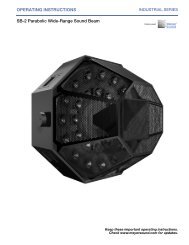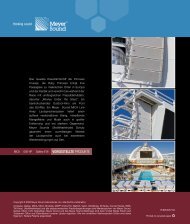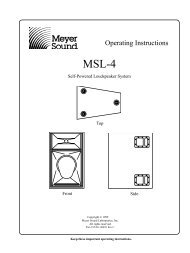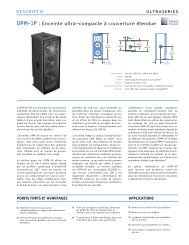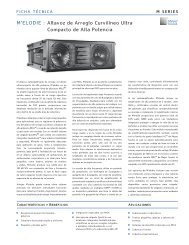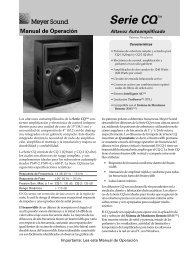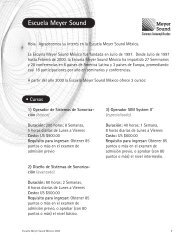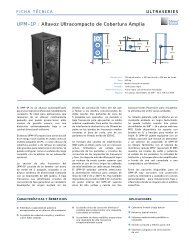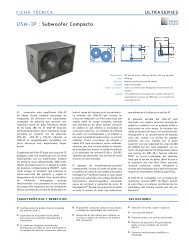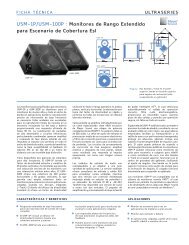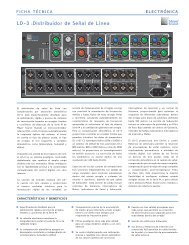Operating Instructions CQ Series - Meyer Sound Laboratories Inc.
Operating Instructions CQ Series - Meyer Sound Laboratories Inc.
Operating Instructions CQ Series - Meyer Sound Laboratories Inc.
Create successful ePaper yourself
Turn your PDF publications into a flip-book with our unique Google optimized e-Paper software.
Fans and Cooling System<br />
The <strong>CQ</strong> uses a forced-air cooling system with two fans<br />
to prevent the amplifiers from overheating. A variablespeed<br />
primary fan runs continuously with an inaudible<br />
operating noise of 22 dBA at 1 m at its slowest speed.<br />
The speed of the primary fan begins increasing when<br />
the temperature of the heatsinks reaches 42°C. The<br />
fan reaches full speed at 62°C and is barely audible near<br />
the cabinet, even without an audio signal.<br />
In the unusual event that the temperature reaches<br />
74°C, the secondary fan turns on and is clearly audible.<br />
The secondary fan turns on in response to<br />
• primary fan failure (check its status immediately);<br />
• high source levels for a prolonged period in hot<br />
temperatures or direct sunlight;<br />
• driver failure.<br />
The secondary fan turns off when the temperature<br />
decreases to 68°C.<br />
In the highly unlikely event that the secondary fan<br />
does not keep the temperature below 85°C, the <strong>CQ</strong><br />
automatically shuts down until AC power is removed<br />
and reapplied. If the <strong>CQ</strong> shuts down again after cooling<br />
and reapplying AC power, contact <strong>Meyer</strong> <strong>Sound</strong> for<br />
repair information.<br />
The fans draw air in through ducts on the front of the<br />
cabinet, over the heatsinks, and out the rear of the<br />
cabinet. Since dust does not accumulate in the amplifier<br />
circuitry, its life span is increased significantly. Make<br />
sure that the air ducts are clear and that there is at<br />
least 6 inches clearance for exhaust behind the cabinet.<br />
air<br />
cooling<br />
fans<br />
heatsinks<br />
power<br />
supply<br />
A foam insert filter, in combination with the entire<br />
front grill surface, acts as an air filter for the cooling<br />
system. Despite the filtering, extensive use or a dusty<br />
operating environment can allow dust to accumulate<br />
along the path of the airflow, preventing normal cooling.<br />
We recommend periodically removing the grill, filter,<br />
and amplifier module and using compressed air to<br />
clear dust from the grill, filter, fans, and heatsinks.<br />
Rigging<br />
The maximum recommended load for a <strong>CQ</strong> with aircraft<br />
pan fittings is 500 lb (228kg). This working load<br />
is one-fifth the cabinet’s breaking strength. The <strong>CQ</strong><br />
has two rigging brackets on both the top and bottom<br />
of the cabinet; each bracket is capable of supporting<br />
the full working load of the cabinet.<br />
!<br />
rigging brackets<br />
(two on top, two on bottom)<br />
Handles are for carrying only.<br />
Do not use them for rigging!<br />
There are four types of interchangeable rigging brackets,<br />
each fastened by six Phillips screws:<br />
• aircraft pan fittings (ring and stud)<br />
• 3 /8”-16 nut plates<br />
• M-10 x 1.5 metric nut plates<br />
• blank plates (if no rigging brackets are requested)<br />
NOTE: Units with nut plates are rated for the weight of<br />
one cabinet only.<br />
Rigging load ratings assume a straight tensile pull and<br />
that the cabinet is in new condition with aircraft pan<br />
fittings. If these conditions are not met, the load ratings<br />
can be reduced significantly. Load ratings can also be<br />
reduced by age, wear, and damage. It is important to<br />
inspect the rigging hardware regularly and replace<br />
worn or damaged components immediately.<br />
The standard model should not be installed outdoors<br />
without weather protection. The cabinet, exposed<br />
electronic circuitry, and drivers can all receive weather<br />
protection treatment that allows the unit to be used<br />
safely in wet conditions. Contact <strong>Meyer</strong> <strong>Sound</strong> for<br />
information about weather-protected units.<br />
NOTE: All <strong>Meyer</strong> <strong>Sound</strong> products must be used in<br />
accordance with local, state, federal, and industry<br />
regulations. It is the owner’s and/or user’s responsibility<br />
to evaluate the reliability of any rigging method for<br />
their application. Rigging should be done only by<br />
experienced professionals.<br />
7



